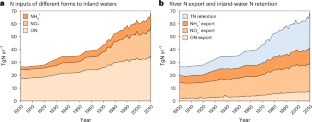Global inland-water nitrogen cycling has accelerated in the Anthropocene
引用次数: 0
Abstract
Inland waters are an important component of the global nitrogen (N) cycle, functioning not only as land-to-sea transporters but also as active biogeochemical reactors. However, the latter role is not well understood regarding mechanisms, quantities or on a global scale. It remains unclear whether, when, how and why global inland-water biogeochemical N cycling has changed. Here we analyse the dynamic global inland-water N cycling processes in the Anthropocene by quantifying the long-term changes in different N forms, including their inputs to inland waters, transformation pathways, retention within inland waters, and river export to oceans. Using a spatially explicit, mechanistic, coupled hydrology and biogeochemistry model, we show that, during 1900–2010, the increase in total nitrogen (TN) river loading (from 27 to 68 Tg yr−1) resulted in an increase in TN export to oceans (from 20 to 42 Tg yr−1), despite an increase in inland-water retention (from 25% to 39%) primarily due to gaseous loss and burial. Moreover, the relative contributions of ammonium (NH4+), nitrate/nitrite (NOx−) and organic nitrogen (ON) changed because of threefold increases in global inland-water mineralization (transforming ON to NH4+) and N burial in sediments, a fourfold increase in nitrification (transforming NH4+ to NOx−) and a sixfold increase in denitrification (transforming NOx− to mainly N2). This Article presents a comprehensive analysis of the dynamic global inland-water N cycling processes using a coupled model of hydrology, nutrient loading and biogeochemical transformation, showing that N export increased more slowly than loading due to increased inland-water retention via enhanced transformation and burial.


人类世加速了全球内陆水域的氮循环
内陆水域是全球氮(N)循环的重要组成部分,它不仅是陆地到海洋的运输工具,还是活跃的生物地球化学反应器。然而,人们对后者的作用机制、数量或在全球范围内的作用还不甚了解。目前仍不清楚全球内陆水体生物地球化学氮循环是否、何时、如何以及为何发生了变化。在此,我们通过量化不同氮形式的长期变化,包括其对内陆水域的输入、转化途径、在内陆水域的滞留以及向海洋的河流输出,分析了人类世全球内陆水域氮循环的动态过程。通过使用空间明确、机械耦合的水文和生物地球化学模型,我们发现在 1900-2010 年期间,尽管主要由于气态流失和掩埋,内陆水域的保留率有所提高(从 25% 提高到 39%),但河流总氮(TN)负荷的增加(从 27 吨/年增加到 68 吨/年)导致向海洋输出的 TN 增加(从 20 吨/年增加到 42 吨/年)。此外,铵(NH4+)、硝酸盐/亚硝酸盐(NOx-)和有机氮(ON)的相对贡献也发生了变化,这是因为全球内陆水矿化(将ON转化为NH4+)和沉积物中氮埋藏量增加了三倍,硝化(将NH4+转化为NOx-)增加了四倍,反硝化(将NOx-主要转化为N2)增加了六倍。本文利用水文、营养物质负荷和生物地球化学转化的耦合模型,对全球内陆水体氮的动态循环过程进行了全面分析,结果表明,由于转化和掩埋作用增强,内陆水体的氮截留量增加,氮出口量的增加速度比负荷量的增加速度要慢。
本文章由计算机程序翻译,如有差异,请以英文原文为准。
求助全文
约1分钟内获得全文
求助全文

 求助内容:
求助内容: 应助结果提醒方式:
应助结果提醒方式:


